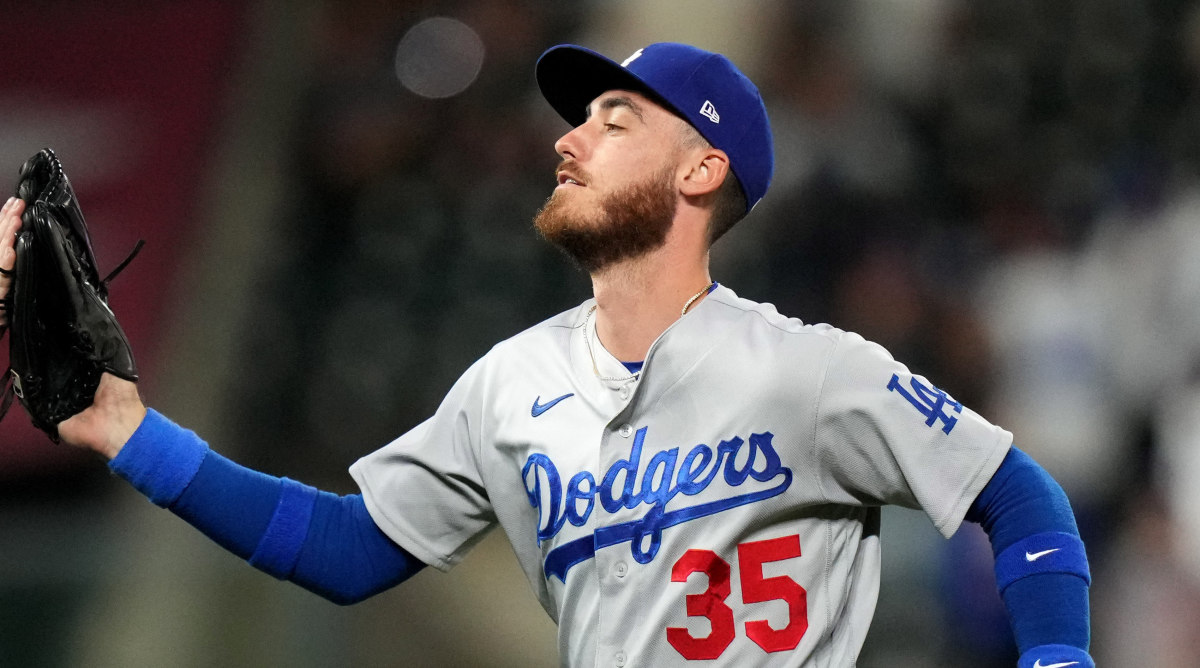A Cautiously Optimistic Cody Bellinger Update
Welcome to The Opener, where every weekday morning during the regular season you’ll get a fresh, topical story to start your day from one of SI.com’s MLB writers.
When Cody Bellinger stepped to the plate in the seventh inning of Sunday’s game against the Padres, he had already done more than his part for the cause. The Dodgers’ center fielder had hit safely in each of the first two games of the series—both wins—and homered in the third inning of the finale to stake Los Angeles to an early lead. Then, he made history.
Bellinger took Luis García deep for his second home run of the game, becoming the first player in Dodgers history to have two multi-home run games against the Padres in the same season. If that sounds like too niche of an accomplishment to merit a mention, well, that’s understandable. But considering the slide Bellinger has been on for the better part of the past three seasons, any milestone is worth celebrating. As the Dodgers prepare for yet another postseason run, though, there are signs that the former MVP is, if not turning a corner, then at least approaching one.

The odyssey of Bellinger from 23-year-old MVP to sub-replacement level regular is, by now, well documented. His 2019 campaign stands out as one of the best from a young hitter in league history. In winning the National League MVP award, Bellinger homered 47 times with 15 stolen bases and a 167 OPS+, meaning he was 67 percent better than the average MLB hitter. Among players that young who had at least 30 homers and 15 stolen bases in the same season, his OPS+ is the fifth-highest of the modern era, trailing only Ken Griffey Jr. (171 in 1993), Jose Canseco (170 in ‘88) and Mike Trout (169 in 2014 and 168 in ‘12).
Then, the bottom dropped out. Bellinger regressed during the pandemic-shortened 2020 campaign and suffered a dislocated shoulder during the playoffs that required surgery in the offseason. That certainly played a role in his 2021 performance, which was among the worst offensive showings ever for an everyday player. Bellinger had a 44 OPS+, and among players who received at least 350 plate appearances in a single season, his .165 batting average ranks as the fifth-lowest since the dawn of the 20th century, better than only Bill Bergen (.139 in 1909 and .159 in ‘06), Adam Dunn (.159 in 2011) and Jackie Bradley Jr. (.163, also last year). He hasn’t been as bad at the plate this season, though certainly not good, with an OPS+ of 84 even after Sunday’s performance.
Given the widespread acceptance of defensive shifts for the past decade, it’s easy to point to changing defensive alignments when a hitter—particularly a left-handed hitter—sees his production fall off a cliff. But Bellinger was already being routinely shifted against by the time he won the MVP, and his production in those rare instances when he’s not facing the shift hasn’t been good over the past few seasons, either. His pull rate has also remained more or less steady:
Year | PA % vs. Shift | wOBA vs. Shift | wOBA (No shift) | Pull % |
|---|---|---|---|---|
2019 | 80.2% | .410 | .433 | 47.9% |
2020 | 91.7% | .330 | .414 | 45.6% |
2021 | 91.3% | .233 | .274 | 45.1% |
2022 | 90.9% | .292 | .285 | 46.3% |
Still, if you squint hard enough, there are reasons to believe Bellinger’s form is trending upward. A lot went wrong for Bellinger in ’20 and ’21, among them an inability to hit fastballs. After posting a .661 slugging percentage against heaters in ’19, he failed to top the .360 mark in either of the two subsequent seasons. This year, he’s hitting .257 on fastballs with a .514 slugging percentage—not quite at his ’19 levels, but no longer getting blown away by the hard stuff.
Specifically, Bellinger has returned to doing more damage on pitchers lower in the zone. Even more specifically, he’s thriving once more on sinkers. Bellinger is batting .327 with a .727 slugging percentage against the pitch this year after posting a woeful .103 batting average on sinkers last year. Both of Bellinger’s homers on Sunday came against sinkers, and though García’s sinker has not been effective this year, Yu Darvish’s has been: hitters have a mere .197 average against Darvish’s sinker this season, and prior to Bellinger’s bomb had managed just two extra-base hits in over 100 plate appearances.
Watch MLB games all season long with fuboTV: Start a free trial today.
So among the ways that pitchers have been beating Bellinger in the past three seasons, fastballs and sinkers are now not as effective. Still, that doesn’t mean Bellinger’s swing is without holes. He’s still plenty susceptible to breaking balls and offspeed pitches, particularly sliders, against which he’s batting a paltry .154. Through nearly 400 plate appearances this year, his 27.7% strikeout rate would be a career worst in a single season.
But even though his on-the-surface numbers have been fairly stagnant—he’s hitting .217/.267/.434 since the start of July, and his season batting average hasn’t been above .220 since the end of May—the signs that actual improvement is happening are there. Bellinger has a 39% hard-hit rate over his last 100 plate appearances, per Baseball Savant, which isn’t far off his career mark of 41.6%. His expected slugging percentage over that span is .383—not exactly the mark of a viable middle-of-the-lineup presence, but the highest it's been since mid-May.
Perhaps most important, though, is the decline of his strikeout rate: it’s down to 21% during this stretch, finally inching below the league’s average for the first time in over a year. Bellinger was once a high-contact hitter, striking out just 16.4% of the time during his MVP campaign. He may never get back to that profile, but at least the whiffs are trending in the right direction.
How the Dodgers handle Bellinger’s arbitration this offseason will be fascinating. He’s proved himself to be a valuable contributor this season, as his speed and defense remain assets. A slightly below-average hitter who plays standout defense at a premium position with strong base running is undoubtedly valuable. But he’s making $17 million this season and will likely ask for more in ‘23, his final year before becoming a free agent. Another factor to consider: the Dodgers have no shortage of high-priced players set to hit free agency in the winter (Trea Turner and Clayton Kershaw chief among them).
Bellinger has not been an MVP-caliber player for some time, and he still isn’t. But he doesn’t need to be in order to become an x-factor for another Los Angeles postseason run. And as he proved over the weekend against a likely October opponent, on any given night, he could be the one to make all the difference.
More MLB Coverage:
• Most Interesting Under-the-Radar Trade Deadline Deals
• Making Sense of Some Puzzling Trade Deadline Decisions
• The Beautiful Life of Vin Scully
• The Smaller Vin Scully Made Himself, the Larger He Became
• The Padres Are the Ideal Team for Baseball Fans
